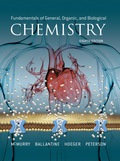
Concept explainers
(a)
Interpretation:
The cyclopentanone treated with Tollens reagent, Benedict’s reagent it will give positive result or negative result it should be identified.
Concept Introduction:
Oxidation: Generally alcohols can be oxidized to
In aldehyde oxidation the hydrogen bonded to the carbonyl carbon is replaced by a hydroxyl group. Moreover
(b)
Interpretation:
The Hexanal treated with Tollens reagent and Benedict’s reagent it will give positive result (or) negative result it should be identified.
Concept Introduction:
Tollens reagent: This test is used in
Benedict’s reagent: This reagent was extensively used as a test for surges in the urine, which are primarily aldehyde and alpha hydroxyl ketones.
(c)
Interpretation:
Given molecule (c) treated with Tollens reagent and Benedict’s reagent it will give positive result (or) negative result it should be identified.
Concept Introduction:
Tollens reagent: This test is used in organic chemistry to test for the presence of aldehydes. In this reaction, an aldehyde is oxidized to a carboxylic acid while the
Benedict’s reagent: This reagent was extensively used as a test for surges in the urine, which are primarily aldehyde and alpha hydroxyl ketones.
Trending nowThis is a popular solution!

Chapter 15 Solutions
EBK FUNDAMENTALS OF GENERAL, ORGANIC, A
- Which type of enzyme catalyses the following reaction? oxidoreductase, transferase, hydrolase, lyase, isomerase, or ligase.arrow_forward+NH+ CO₂ +P H₂N + ATP H₂N NH₂ +ADParrow_forwardWhich type of enzyme catalyses the following reaction? oxidoreductase, transferase, hydrolase, lyase, isomerase, or ligase.arrow_forward
- Which features of the curves in Figure 30-2 indicates that the enzyme is not consumed in the overall reaction? ES is lower in energy that E + S and EP is lower in energy than E + P. What does this tell you about the stability of ES versus E + S and EP versus E + P.arrow_forwardLooking at the figure 30-5 what intermolecular forces are present between the substrate and the enzyme and the substrate and cofactors.arrow_forwardprovide short answers to the followings Urgent!arrow_forward
- Pyruvate is accepted into the TCA cycle by a “feeder” reaction using the pyruvatedehydrogenase complex, resulting in acetyl-CoA and CO2. Provide a full mechanismfor this reaction utilizing the TPP cofactor. Include the roles of all cofactors.arrow_forwardB- Vitamins are converted readily into important metabolic cofactors. Deficiency inany one of them has serious side effects. a. The disease beriberi results from a vitamin B 1 (Thiamine) deficiency and ischaracterized by cardiac and neurological symptoms. One key diagnostic forthis disease is an increased level of pyruvate and α-ketoglutarate in thebloodstream. How does this vitamin deficiency lead to increased serumlevels of these factors? b. What would you expect the effect on the TCA intermediates for a patientsuffering from vitamin B 5 deficiency? c. What would you expect the effect on the TCA intermediates for a patientsuffering from vitamin B 2 /B 3 deficiency?arrow_forwardDraw the Krebs Cycle and show the entry points for the amino acids Alanine,Glutamic Acid, Asparagine, and Valine into the Krebs Cycle - (Draw the Mechanism). How many rounds of Krebs will be required to waste all Carbons of Glutamic Acidas CO2?arrow_forward
 Principles Of Radiographic Imaging: An Art And A ...Health & NutritionISBN:9781337711067Author:Richard R. Carlton, Arlene M. Adler, Vesna BalacPublisher:Cengage Learning
Principles Of Radiographic Imaging: An Art And A ...Health & NutritionISBN:9781337711067Author:Richard R. Carlton, Arlene M. Adler, Vesna BalacPublisher:Cengage Learning- Essentials of Pharmacology for Health ProfessionsNursingISBN:9781305441620Author:WOODROWPublisher:CengageSurgical Tech For Surgical Tech Pos CareHealth & NutritionISBN:9781337648868Author:AssociationPublisher:Cengage





